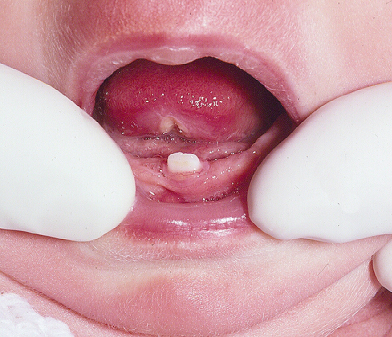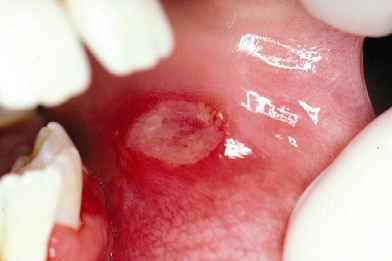37
Ulcers and Vesiculobullous Lesions in Children
Diagnosis
Ulceration is a non-specific sign of full-thickness epithelial breakdown. It may occur as a result of trauma (Fig. 37.1), such as biting the lip following an inferior alveolar nerve block injection, viral infection or immunological disease (Fig. 37.2), including any of the conditions mentioned later. Any ulcerative lesion in a child that fails to resolve within 2 weeks requires further investigation. While the aetiology of most ulcers may be determined by history and examination, long-standing or recurrent ulceration in children often requires investigative blood tests and possibly biopsy. Blood investigations might include:
- full blood count with differential white cell count;
- electrolytes;
- iron studies including ferritin, red cell folate and total iron-binding capacity;
- serum vitamin B12;
- anti-nuclear antibodies;
- anti-gliadin antibodies;
- serum angiotensin converting enzyme (ACE);
- C-reactive protein.
Figure 37.1 A traumatic ulcer in an infant on the ventral surface of the tongue. This is termed Riga-Fedé ulceration and is often seen in children with cerebral palsy and is caused by rubbing of the tongue over the newly erupted lower incisors.

Figure 37.2 A deep painful ulcer in an immunocompromised child. Any ulcer that does not heal within 2 weeks requires further investigation.

Management of Oral Ulceration
In most cases the management is symptomatic and empirical but treatment of any underlying nutritional or haematological deficiency is paramount. Topical antiseptics and steroids give some relief and, in severe cases, systemic steroids may be required:
- mouthrinses:
- 0.2% chlorhexidine gluconate;
- 1.2% benzydamine hydrochloride;
- sulfasalazine;
- topical steroids:
- triamcinolone in Ora/>
Stay updated, free dental videos. Join our Telegram channel

VIDEdental - Online dental courses


